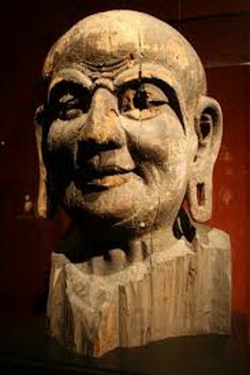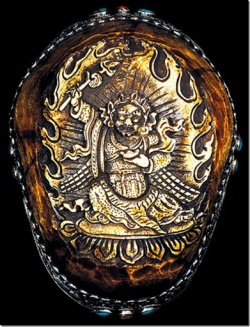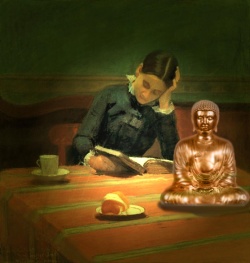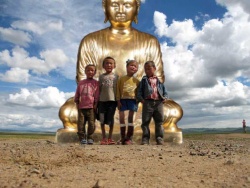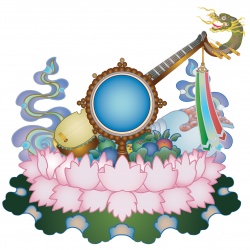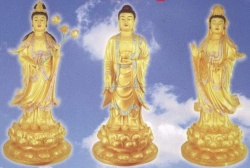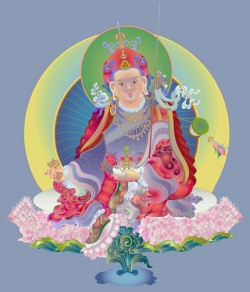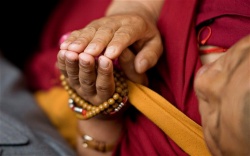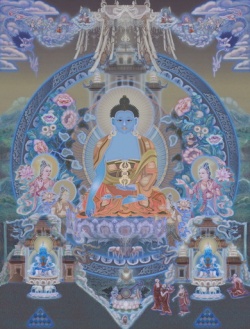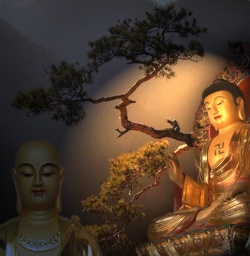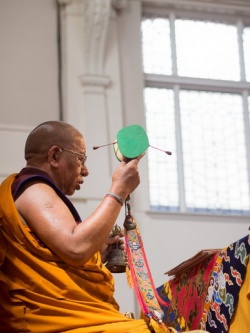Kashyapa
Kashyapa (འོད་སྲུང་, ‘od srung)
Sanskrit: Kasyapa Buddha;
Pāli: Kassapa Buddha;
Chinese : 迦葉佛
Japanese : 迦葉; かしょう; Kashō
Mongolian : ᠭᠡᠷᠡᠯ ᠰᠠᠬᠢᠭᠴᠢ, Гашив, (Geshib)
Tibetan : འོད་སྲུང་ཆེན་པོ (Ösung Chenpo)
Vietnamese : Phật Ca-Diếp
Sinhala : කස්සප බුද්ධ
Kashyapa (Skt)
迦葉菩薩 ( Jpn Kasho-bosatsu)
(1) A bodhisattva who appears in the Mahaparinirvana Sutra to whom Shakyamuni Buddha addresses the "Bodhisattva Kashyapa" chapter of that sutra and who, in the sutra, asks Shakyamuni thirty-six questions.
(2)[迦葉仏]( Jpn Kasho-butsu): According to the Long Agama Sutra and others, the sixth of the seven Buddhas of the past, the seventh and last of whom is Shakyamuni. The Wise Kalpa Sutra lists the names of a thousand Buddhas appearing in the present Wise Kalpa and describes Kashyapa Buddha as the third of them. According to the Mahaparinirvana Sutra, the monk Realization of Virtue, who upheld the correct teaching, was reborn as Kashyapa Buddha, and the king Possessor of Virtue, who was killed defending him, was reborn as Shakyamuni.
Source
Buddha Kashyapa (Skt. Kāśyapa; Tib. འོད་སྲུང་, Wyl. 'od srung) is the supreme nirmanakaya buddha immediately preceding Buddha Shakyamuni in this Fortunate Aeon—the third of the 1002 buddhas of this Fortunate Aeon. According to the Basic vehicle, he is also the sixth of the seven heroic buddhas.
Further Reading
The Fortunate Aeon: How the Thousand Buddhas Became Enlightened (Berkeley: Dharma Publishing, 1986), volume 2, page 521.
Source
Kāśyapa. (P. Kassapa; T. ’Od srung; C. Jiashe; J. Kashō; K. Kasŏp 迦葉). Sanskrit proper name of one of the seven buddhas of antiquity (Saptatathāgata) who preceded the current buddha Śākyamuni and, by some accounts, the buddha who predicted Śākyamuni’s own eventual enlightenment. He is also sometimes mentioned in a list of three past buddhas, along with Krakucchanda and Kanakamuni.
Kāśyapa is also the name of one of the Buddha’s ten main disciples, who is usually known to the tradition as “Kāśyapa the Great”; see Mahākāśyapa.
Source
The Princeton Dictionary of Buddhism by Robert E. Buswell Jr. and Donald S. Lopez Jr.
Buddha Kashyapa was the third Buddha to appear in this world and turn the Wheel of Dharma, the previous two being Buddha Krakuchchanda and Buddha Kanakamuni. Buddha Shakyamuni was the fourth, and Buddha Maitreya will be the fifth.
Kashyapa is a manasaputra (wish-born-son) of Lord Brahma. However, according to [Rama:1.70.20], he is the grand son of Lord Brahma, being the son of Marichi, a wish-born son of Lord Brahma. Kashyapa had many wives, most of them the daughters of Daksha prajapathi.
His wives (who are daughters of Daksha) are :
- Aditi mother of the Devas,
- Diti the mother of the Asuras,
- Arishta, the mother of the Gandharvas,
- Kadru, the mother of the Nagas (snakes),
- Vinata the mother of Varuna and Garuda,
- Danu the mother of the Danavas (who are generally considered part of the Asuras),
- Kalaka the mother of the monster Kalkanja,
- Khasa, the mother of the Yakshas,
- Krodhavasa the mother of the Pishachas (flesh eating monsters),
- Muni the mother of Maumeya,
- Puloma the mother of the monster Pauloma,
- Somathi the mother of Sumathi (who married Sagara, the sea).
Kashyapa (कश्यप): An ancient sage, father of the Devas, Asuras, Nagas and all of humanity. He is married to Aditi, with whom he is the father of Agni and the Savitrs. His second wife, Diti, begot the Daityas. Diti and Aditi were daughters of King Daksha and sisters to Sati, Shiva's consort. One of Dashratha's counsellors also.
Source
In Buddhist tradition, Kassapa is the name of a Buddha, the third of the five Buddhas of the present aeon (the Bhaddakappa or Fortunate Aeon), and the sixth of the six Buddhas prior to the historical Buddha mentioned in the earlier parts of the Pali Canon(D.ii.7). In the Buddhist texts in Sanskrit, this Buddha is known as Kasyapa.
1. Kassapa Buddha - Also called Kassapa Dasabala to distinguish him from other Kassapas.
The twenty fourth Buddha, the third of the present neon (the Bhaddakappa) and one of the seven Buddhas mentioned in the Canon (D.ii.7).
He was born in Benares, in the Deer Park at Isipatana, of brahmin parents, Brahmadatta and Dhanavati, belonging to the Kassapagotta.
For two thousand years he lived in the household, in three different palaces, Hamsa, Yasa and Sirinanda. (The BuA.217 calls the first two palaces Hamsava and Yasava).
He had as chief wife Sunanda, by whom he begot a son, Vijitasena.
Kassapa left the world, traveling in his palace (pasada), and practiced austerities for only seven days.
Just before his Enlightenment his wife gave him a meal of milk rice, and a yavapala named Soma gave him grass for his seat.
His bodhi was a banyan tree, and he preached his first sermon at Isipatana to a crore of monks who had renounced the world in his company.
He performed the Twin Miracle at the foot of an asana tree outside Sundaranagara.
He held only one assembly of his disciples; among his most famous conversions was that of a yakkha, Naradeva (q.v.).
His chief disciples were Tissa and Bharadvaja among monks, and Anula and Uruvela among nuns, his constant attendant being Sabbamitta.
Among his patrons, the most eminent were Sumangala and Ghattikara, Vijitasena and Bhadda.
His body was twenty cubits high, and, after having lived for twenty thousand years, he died in the Setavya pleasance at Setavya in Kasi.
Over his relics was raised a thupa one league in height, each brick of which was worth one crore.
It is said (MA.i.336ff ) that there was a great difference of opinion as to what should be the size of the thupa and of what material it should be constructed; when these points were finally settled and the work of building had started, the citizens found they had not enough money to complete it. Then an anagami devotee, named Sorata, went all over Jambudipa, enlisting the help of the people for the building of the thupa. He sent the money as he received it, and on hearing that the work was completed, he set out to go and worship the thupa; but he was seized by robbers and killed in the forest, which later came to be known as the Andhavana.
Upavana, in a previous birth, became the guardian deity of the cetiya, hence his great majesty in his last life (DA.ii.580; for another story of the building of the shrine see DhA.iii.29).
Among the thirty seven goddesses noticed by Guttila, when he visited heaven, was one who had offered a scented five spray at the cetiya (J.ii.
Source
In Buddhist tradition, Kassapa (Pāli) is the name of a Buddha, the third of the five Buddhas of the present kalpa (the Bhaddakappa or 'Fortunate Aeon'), and the sixth of the six Buddhas prior to the historical Buddha mentioned in the earlier parts of the Pali Canon (D.ii.7). In the Buddhist texts in Sanskrit, this Buddha is known as Kāśyapa.
Life
Kassapa was born in India. His parents were the Brahmins Brahmadatta and Dhanavatī, of the Kashyap Gotra.
According to legend, his body was twenty cubits high, and he lived for two thousand years in three different palaces. They are Hamsa, Yasa, and Sirinanda. (The BuA.217 calls the first two palaces Hamsavā and Yasavā). His chief wife was Sunandā, who bore him a son named Vijitasena.
Kassapa gave up his worldly life traveling in his palace (pāsāda). He practiced austerities for only seven days. Just before attaining enlightenment, he accepted a meal of milk-rice from his wife and grass for his seat from a yavapālaka named Soma. His bodhi (the tree under which he attained enlightenment) was a banyan tree, and he preached his first sermon at Isipatana to an assembly of monks who had renounced the world in his company.
Kassapa performed the Twin Miracle at the foot of an asana tree outside Sundar Nagar, India. He held only one assembly of his disciples; among his most famous conversions was that of Nāradeva, a Yaksha. His chief disciples among monks were Tissa and Bhāradvāja, and among nuns were Anulā and Uruvelā, his constant attendant being Sabbamitta. Among his patrons, the most eminent were Sumangala and Ghattīkāra, Vijitasenā, and Bhaddā.
Kassapa died at the age of forty thousand years, in the city of Kashi, in the Kasi Kingdom (now known as Varanasi, in the modern-day Indian state of Uttar Pradesh. Over his relics was raised a thūpa one league in height, each brick of which was worth one crore (ten million) rupees.
The Stupa of Kassapa Buddha
There was initially a great difference of opinion on what should be the size of the stupa and of what material it should be built. Construction of the stupa was begun after these issues were finally settled. But then the citizens found they lacked sufficient funds to complete the stupa. An anāgāmī devotee named Sorata travelled throughout Jambudipa, requesting money from the people for the completion of the stupa. He sent the money as he received it, and on hearing that the work was completed, he set out to go and worship the stupa. However, he was seized by robbers and murdered in the forest, which later came to be known as the Andhavana.
Upavāna, in a previous birth, became the guardian deity of the stupa, hence his great majesty in his last life (DA.ii.580; for another story of the building of the shrine see DhA.iii.29).
Among the thirty-seven goddesses noticed by Guttila when he visited heaven was one who had offered a scented five-spray at the stupa (J.ii.256). Alāta offered āneja-flowers and obtained a happy rebirth (J.vi.227).
The cause of Mahā-Kaccāna's golden complexion was his gift of a golden brick to the building of Kassapa's shrine (AA.i.116). At the same stupa, Anuruddha, who was then a householder in Benares, offered butter and molasses in bowls of brass, which were placed without any interval around the stupa (AA.i.105).
Manushi Buddhas
In addition to Kassapa Buddha, the other four Buddhas of the present kalpa Manushi Buddhas):
Source
Kassapa is the name of a Buddha, the third of the five Buddhas of the present aeon (the Bhaddakappa or 'Fortunate Aeon'), and the sixth of the six Buddhas prior to the historical Buddha mentioned in the earlier parts of the Pali Canon(D.ii.7). In the Buddhist texts in Sanskrit, this Buddha is known as Kāśyapa.
Kassapa Buddha was one of the 28 Buddhas of this world system and the Samma-sam-buddha directly before Gotama Buddha, the Buddha of our time.
Kassapa was born in Varanasi, in the Deer Park at Isipatana, India for his Brahmin parents Brahmadatta and Dhanavatī, of the Kassapagotta. Kassapa lived for two thousand years in the household in three different palaces. They are Hamsa, Yasa and Sirinanda. (The BuA.217 calls the first two palaces Hamsavā and Yasavā). His chief wife was Sunandā and had a son called Vijitasena. Kassapa gave up his worldly life traveling in his palace (pāsāda). He practiced austerities for only seven days. Just before attaining enlightenment he had accepted a meal of milk-rice from his wife and grass for his seat from a yavapālaka named Soma. His bodhi (the tree under which he attained enlightenment) was a banyan-tree and he preached his first sermon at Isipatana to an assembly of monks who had renounced the world in his company. Kassapa performed the twin miracle at the foot of an asana-tree outside Sundaranagara. He held only one assembly of his disciples; among his most famous conversions was that of a yakkha, Naradeva (q.v.). His chief disciples were Tissa and Bhāradvāja among monks, and Anulā and Uruvelā among nuns, his constant attendant being Sabbamitta. Among his patrons, the most eminent were Sumangala and Ghattīkāra, Vijitasenā and Bhaddā. His body was twenty cubits high. Kassapa dies at the age of forty thousand years, in the Setavya pleasance at Setavyā in Kāsī. Over his relics was raised a thūpa one league in height, each brick of which was worth one crore.
There has been a great dissimilarity of opinion on what should be the size of the stupa and using what material it should be built. These points have been finally settled and the work of building was started. But then the citizens found they had not enough money to complete the thupa. In order to find this money, an anāgāmī devotee, named Sorata, went all over Jambudīpa, requesting the help of the people for the completion of the thūpa. He sent the money as he received it, and on hearing that the work was completed, he set out to go and worship the thūpa; but he was seized by robbers and killed in the forest, which later came to be known as the Andhavana. Upavāna, in a previous birth, became the guardian deity of the chetiya, hence his great majesty in his last life (DA.ii.580; for another story of the building of the shrine see DhA.iii.29). Among the thirty-seven goddesses noticed by Guttila, when he visited heaven, was one who had offered a scented five-spray at the chetiya (J.ii.256). So did Alāta offer āneja-flowers and obtain a happy rebirth (J.vi.227). The cause of Mahā-Kaccāna's golden complexion was his gift of a golden brick to the building of Kassapa's shrine (AA.i.116). At the same chetiya, Anuruddha, who was then a householder in Benares, offered butter and molasses in bowls of brass, which were placed without any interval around the chetiya (AA.i.105).
Since there is no archeological evidence for the existence of Kassapa, he is placed in the Legendary figures category. But for Theravada Buddhists and most other Buddhists, Kassapa was a real person who became a Buddha.
Source
Kasyapa (Third Manushi-Buddha)
(The Keeper of Light)
(T.) hod-srun (luminous protector).
(M.) ghasiba (from the Sanskrit) or gerel-sakiqci (luminous protector).
Mudra: vara (charity).
Vahana: lion.
Colour: yellow.
Bodhi-tree: banyan.
Dhyani-Bodhisattva: Ratnapani.
Dhyani-Buddha: Ratnasambhava.
Manushi-Buddha: Kasyapa.
Kasyapa was Manushi-Buddha in the Jcalpa preceding that of Sakya-muni who had been his disciple in a former halpa, and whose eventual Buddhahood he had predicted. He lived on earth 20,000 years and converted 20,000 people.
It is believed that he is buried under Mount Kukkutapada, in Northern India, near Bodh-Gaya, and that when Maitreya comes upon earth as a Manushi-Buddha, he will go first to the mountain which will open miraculously. Kasyapa will then come forth and give to Maitreya the garments of a Buddha, after which his body will be consumed by holy fire and he will enter Nirvana.
According to the Mahayana system, Kasyapa is the third Manushi-Buddha of the group of five, and the sixth of the group of seven ancient Buddhas.
Kasyapa is sometimes represented seated on a Lion Throne, and is always clothed like a Buddha. His right hand is in 'charity' mudra, and his left holds a fold of his monastic garment. The two folds held in the hand look like the ears of an animal.
